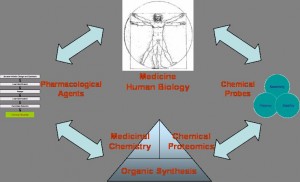Research
RESEARCH INTERESTS:
Our group is trail-blazing a novel approach for quantitative chemical biology. We combine cutting-edge medicinal chemistry and emerging chemical proteomics to advance our understanding of diseases and discover new therapeutic agents.
1. Medicinal Chemistry Research on Oncology and Immune System Targets
Oncology and immune system disorders are debilitating diseases with tremendous unmet medical needs. For many types of cancer, abnormal activities of numerous protein families are rampant and well documented by large quantity of biological data. We focus our medicinal chemistry efforts on these two types of diseases, and are making significant progresses in providing preclinical drug candidates for further development.
2. Theory and Practice of Covalent Probes
Covalent probes and drugs are clearly in a rapid expansion stage. Including ibrutinib, these covalent drugs are transforming treatments and outcome in multiple terminal diseases. However, there also are clear needs in developing thorough theoretical understanding of covalent probes/drugs, establishing concise and effective procedures, and expanding targetable amino acids beyond cysteine. We are refining our common practice and apply this procedure into probe development of several classes of targets. We are also developing and testing new and/or existing reactive groups targeting proteinogenic amino acids with nucleophilic groups in their side chains.
3. Quantitative Chemical Biology Approaches – Precision Tools for Studying Signal Transduction
Cellular activities are controlled by biological and chemical signals. Developing chemical methods, especially quantitative tools, for major mediators of signal transduction pathways will give unprecedented understanding of biological processes. We are developing multiple small molecule probes enabling direct detection of kinase activities at their endogenous levels in native living human cells and a method to capture physiological substrates of these marvelous enzymes to understand their temporal and spatial controls in cellular circuitry.


